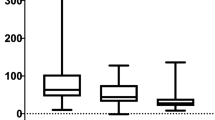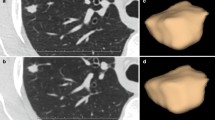Abstract
Purpose
This study was undertaken to assess the performance of 16-slice computed tomography (MSCT) using Multi-Planar Reformatting (MPR), Maximum Intensity Projection (MIP) and Volume Rendering (VR) reconstructions to study pulmonary metastases.
Materials and methods
CT studies of 32 patients with pulmonary metastases were retrospectively reviewed. Images were assessed for the following parameters: number, size, location, distribution of the nodules and the presence of the “mass-vessel sign”. These parameters were evaluated by two observers on axial-source images and on MPR, MIP and VR reconstructions. Sensitivity of each reconstruction and interobserver agreement were calculated.
Results
Two-dimensional (2D) axial images and MIP and VR reconstructions exhibited 100% sensitivity for lesions >10 mm. For nodules 6–10 mm, sensitivity was 49%–55% for the 2D images, 90% for MIP and 80%–85% for VR reconstructions. For metastasis ≤5 mm, sensitivity was 22% for 2D images, 87%–89% for MIP and 55%–58% for VR reconstructions. Coronal and sagittal MPR, MIP and VR did not improve the detection rate compared with the corresponding axial images. MIP and VR provided overlapping results in detecting the “mass-vessel sign”.
Conclusions
MIP are the most sensitive reconstructions for detecting small pulmonary nodules.
Riassunto
Obiettivo
Valutare le potenzialità della tomografia computerizzata a 16 strati (TCMS) utilizzando le ricostruzioni Multi-Planar Reformatting (MPR), Maximum Intensity Projection (MIP) and Volume Rendering (VR) nello studio delle metastasi polmonari.
Materiali e metodi
È stato eseguito uno studio retrospettivo su 32 pazienti con metastasi polmonari. Sono stati valutati per ogni paziente i seguenti parametri: numero, dimensione, localizzazione, distribuzione dei noduli e presenza del “segno del vaso”. Tali parametri, sono stati analizzati da due osservatori nelle immagini assiali, MPR, MIP e VR. Sono state calcolate sensibilità di ciascuna ricostruzione e concordanza tra i due osservatori.
Risultati
Per lesioni >10 mm le immagini assiali 2D, MIP e VR hanno presentato sensibilità del 100%; per noduli di 6–10 mm le 2D del 49%–55%, le MIP del 90% e le VR dell’80%–85%; per metastasi =5 mm le 2D del 22%, le MIP del 87%–89%, le VR del 55%–58%. Le immagini coronali e sagittali MPR, MIP e VR non hanno fornito alcun incremento diagnostico rispetto alle assiali corrispondenti. Le MIP e le VR sono risultate sovrapponibili nel riconoscimento del “segno del vaso”.
Conclusioni
Le MIP sono le ricostruzioni più sensibili nel riconoscimento dei piccoli noduli polmonari.
Similar content being viewed by others
References/Bibliografia
Davis S (1991) CT evaluation for pulmonary metastases in patients with extrathoracic malignancy. Radiology 180:1–12
De Wever W, Ceyssens S, Mortelmans L et al (2007) Additional value of PETCT in the staging of lung cancer: comparison with CT alone, Pet alone and visual correlation of PET and CT. Eur Radiol 17:23–32
Aquino SL (2005) Imaging of metastatic disease to the thorax; Radiol Clin North Am 43:481–495
Muhm JR, Brown LR, Crowe JK (1977) Detection of pulmonary nodules by computed tomography. AJR Am J Roentgenol 128:267–270
Peuchot M, Libshitz HI (1987) Pulmonary metastatic disease: radiologic-surgical correlation. Radiology 164:719–722
Friedmann G, Bohndorf K, Krüger J (1986) Radiology of pulmonary metastases: comparison of imaging techniques with operative findings. Thorac Cardiovasc Surg 34:120–124
Ko JP, Naidich DP (2003) Lung nodule detection and characterization with multislice CT. Radiol Clin N Am 41:575–597
Remy-Jardin M, Remy J, Giraud F, Marquette CH (1993) Pulmonary nodules: detection with thick-section spiral CT versus conventional CT. Radiology 187:513–520
Collie DA, Wright AR, Williams JR et al (1994) Comparison of spiralacquisition computed tomography and conventional computed tomography in the assessment of pulmonary metastatic disease. Br J Radiol 67:436–444
Gruden JF, Ouanounou S, Tigges S et al (2002) Incremental benefit of maximum-intensity-projection images on observer detection of small pulmonary nodules revealed by multidetector CT. AJR Am J Roentgenol 179:149–157
Diederich S, Semik M, Lentshig M et al (1999) Helical CT of pulmonary nodules in patients with extrathoracic malignancy: CT-surgical correlation. AJR Am J Roentgenol 172:353–360
Croiselle P, Souto M, Cova M et al (1995) Pulmonary nodules: improved detection with vascular segmentation and extraction with spiral CT-work in progress. Radiology 197:397–401
Beigelman-Aubry C, Hill C, Guibal A et al (2005) Multidetector row CT and post processing technique in the assessment of diffuse lung disease. Radiographics 25:1639–1652
Spencer H (1985) Secondary tumours in the lung. In: Pathology of the lung. 4th ed. Pergamon, Oxford, pp 1085–1096
Abrahms HL, Spiro R, Goldstein N (1989) Metastases in carcinoma: analysis of 1000 autopsied cases. Cancer 3:74–85
Willis RA (1973) The spread of tumours in the human body, 3d ed. Butterworths, London, pp 167–174
Buthiau D, Breau JL, Piette JC et al (1998) Pulmonary metastasis. In: Buthiau D, Khayat D (eds) CT and MRI in oncology. Springer-Verlag Berlin, Heidelberg, New York, pp 156
Naidich DP, Zerhouni EA, Siegelman SS (1984) Computed tomography of the thorax. Raven, New York, pp 171–199
Mitchell DM, Shah SH, Edwards D et al (1986) Incidence of pulmonary nodules detected by computed tomography in patients with bronchial carcinoma. Clin Radiol 37:151–152
Chang AE, Schaner EG, Conkle DM et al (1979) Evaluation of computed tomography in the detection of pulmonary metastases: a prospective study. Cancer 43:913–916
Friese SA, Rieber A, Fleiter T et al (1994) Pulmonary nodules in spiral volumetric and single slice CT. Eur J Radiol 18:48–51
Wormanns D, Diederich S, Lentschig MG et al (2000) Spiral CT of pulmonary nodules: interobserver variation in assessment of lesion size. Eur Radiol 10:710–713
Buckley JA, Scott WW, Siegelmann SS et al (1995) Pulmonary nodules: effect of increased data sampling on detection of spiral CT and confidence in diagnosis. Radiology 196:395–400
Diederich S, Lentischig MG, Winter F et al (1999) Detection of pulmonary nodules with overlapping versus nonoverlapping image reconstruction at spiral CT. Eur Radiol 9:281–286
Paranjpe DV, Bergin CJ (1994) Spiral CT of the lungs: optimal technique and resolution compared with conventional CT. AJR Am J Roentgenol 162:561–567
Diederich S, Lentschig MG, Overbeck TR et al (2001) Detection of pulmonary at spiral CT: comparison of maximum intensity projection sliding slabs and single image reporting. Eur Radiol 11:1345–1350
Eibel R, Turk TR, Kulinna C et al (2001) Multidetector-row CT of the lungs: multiplanar reconstructions and maximum intensity projections of the detection of the pulmonary nodules. Rofo 173:815–821
Valencia R, Denecke T, Lehmkuhl L et al (2006) Value of axial and coronal MIP images in the detection of pulmonary nodules by multislice spiral CT: comparison with axial 1 mm and 5 mm slices. Eur Radiol 16:325–332
Coakley FV, Cohen MD, Johnson MS et al (1998) Maximum intensity projection images in the detection of simulated pulmonary nodules by spiral CT. Br J Radiol 71:135–140
Peloshek P, Sailer J, Weber M et al (2007) Pulmonary nodules: sensitivity of Maximum Intensity Projection versus that of Volume Rendering of 3D multidetector CT data. Radiology 243:561–569
Jankowski A, Martinelli T, Timsit JF et al (2007) Pulmonary nodule detection MDCT images evaluation of diagnostic performances using than axial images, MIP and CAD. Eur Radiol 17:3148–3156
Lee KW, Kim M, Gierada DS et al (2007) Performance of a computeraided program for automated matching of metastatic pulmonary nodules detected on follow-up chest CT. AJR Am J Roentgenol 189:1077–1081
Brown MS, Goldin JG, Suh RD et al (2003) Lung micronodules: automated method for detection at thin section CT-initial experience. Radiology 226:256–262
Bae KT, Kim JS, Na YH et al (2005) Pulmonary nodules: automated detection on CT images with morphologic matching algorithmpreliminary results. Radiology 236:286–293
Yuan R, Vos PM, Cooperberg PL (2006) Computer-aided detection in screening CT for pulmonary nodules. AJR Am J Roentgenol 186:1280–1287
Saba L, Caddeo MD, Mallarini G (2007) Computer-aided detection of pulmonary nodules in computer tomography: analysis and review of the literature. J Comput Assist Tomogr 31:611–619
Rubin GD, Lyo JK, Paik DS et al (2005) Pulmonary nodules on multidetector row CT scans: performance comparison of radiologist and computer-aided detection. Radiology 234:274–283
Gotway MB, Reddy GP, Webb WR et al (2005) High resolution CT of the lung: patterns of disease and differential diagnosis. Radiol Clin of N Am 43:513–542
Gruden JF, Webb WR, Naidich DP, Mc Guinness G (1999) Multinodular disease: anatomic localization at thin section CT. Multireader evaluation of a simple algorithm. Radiology 210:711–720
Lee KS, Kim T, Han J et al (1999) Diffuse micronodular lung disease: HRCT and pathologic findings. J Comput Assist Tomogr 23:99–106
Zerhouni EA, Naidich DP, Stitik FP et al (1987) CT of the pulmonary parenchyma. J Thorac Imag 2:15–23
Murata K, Takahashi M, Mori M et al (1992) Pulmonary metastatic nodules CT-pathologic correlation. Radiology 182:331–335
Raoof S, Amechentsev A, Vlahos I et al (2006) Pictorial essay: multinodular disease. A high-resolution CT scans diagnostic algorithm. Chest 129:805–815
Milne EN, Zerhouni EA (1987) Blood supply of pulmonary metastases. J Thorac Imaging 2:15–23
Meziane MA, Hruban RH, Zerhouni EA et al (1988) High Resolution CT of the lung parenchyma with pathologic correlation. Radiographics 8:27–54
Dodd JD, Souza CA, Müller NL (2006) High resolution MDCT of pulmonary septic embolism: evaluation of the feeding vessel sign. AJR Am J Roentgenol 187:623–629
Author information
Authors and Affiliations
Corresponding author
Rights and permissions
About this article
Cite this article
Angelelli, G., Grimaldi, V., Spinelli, F. et al. Multi slice computed tomography in the study of pulmonary metastases. Radiol med 113, 954–967 (2008). https://doi.org/10.1007/s11547-008-0313-z
Received:
Accepted:
Published:
Issue Date:
DOI: https://doi.org/10.1007/s11547-008-0313-z




